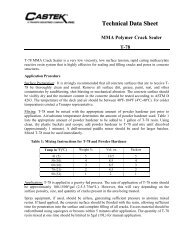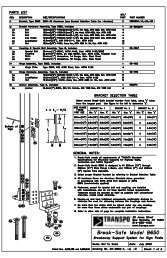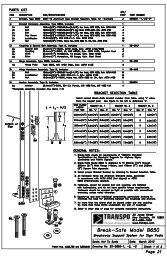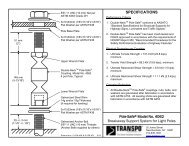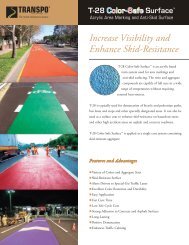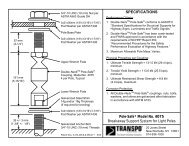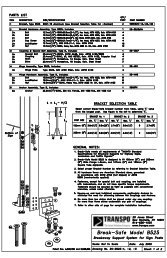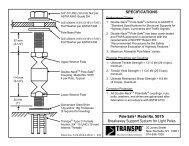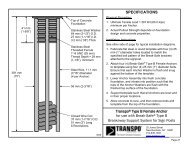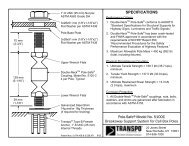Oil Absorbing Pads - Transpo Industries, Inc.
Oil Absorbing Pads - Transpo Industries, Inc.
Oil Absorbing Pads - Transpo Industries, Inc.
You also want an ePaper? Increase the reach of your titles
YUMPU automatically turns print PDFs into web optimized ePapers that Google loves.
X-TEX <strong>Oil</strong> Sorption Propertieshttp://www.xextex.com/testdata/oil_sorption_properties.htmPage 2 of 44/27/04A mixture of 50 percent used motor oil and 50 percent diesel was injected into thePVC delivery pipe using a metering pump. The oil was metered into the influentstream at one gram per minute, and the flow rate was held constant at 10 liters perminute, yielding a 100 mg/l influent waste stream. Although this concentration ismuch higher than actual environmental field conditions, the amount of oil effluentwas sufficient to measure a break-through point of each material.The two materials were tested at both a single and a double thickness at highconcentrations to determine if additional removal efficiencies could be improved byusing more material. Each material tested was exposed to a total of a 10-minuteflow of oil/water effluent. Samples were collected at 1,2,4,6,8 and 10 minuteintervals of filtering. A total of 10 grams of oil was discharged with 100 liters ofwater for each test. The oil/water effluent passed through both materials for alltests without collecting or pooling. Samples were analyzed using EPA 418.1 methodfor total petroleum hydrocarbons.Results- The results from this bench test demonstrate that the X-TEX Blanket outperforms the polypropylene material substantially for the single layer and doublelayers of material.For the single layer the polypropylene break-through of the effluent occurred justafter two minutes of testing with a drop from 84% to 64% removal rate. The X-TEX material maintained a high percent of removal until break-through betweenthe 9th and 10th minutes of the test when the removal rate dropped from 85 % to69 %. There was no break through for the two layered X-TEX material or thepolypropylene textile under the test conditions. Table 1 summarizes these results,and Graph 1 shows these test results in percentages.Diesel / Motor <strong>Oil</strong> Removal from Water – Polypropylene Textile vs. X-TEX BlanketTable 1Time (min)Amount of Diesel/<strong>Oil</strong>AddedTotal(grams)<strong>Oil</strong>/Water(ppm)Amount ofDiesel/<strong>Oil</strong>Removed (ppm)PPL Insert X-TEX PPL InsertAmount of Diesel/<strong>Oil</strong>Removed (percent)X-TEX1 0.88 88 65 87 74 992 1.76 88 74 87 84 994 3.52 88 56 86 64 976 5.28 88 31 75 36 858 7.04 88 20 75 23 8510 8.8 88 17 61 20 70Graph 1- Percent of removal for single layer test




